Hello readers! In this post, we’ll discuss the different types of evaporators and their applications using illustrations.
So let’s start with what is an evaporator.
What is Evaporator?
Evaporation is a common and versatile process used in the chemical and process industries. These include concentrating solutions (often as a step before the solute crystallizes), revalorizing liquefied gases, cooling or chilling applications, and producing pure and mixed vapors for process use.
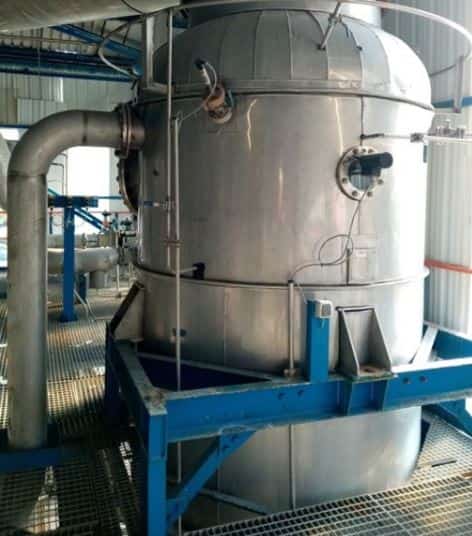
Evaporators use heat transfer to convert liquids to gaseous states. Every basic evaporator has a mechanism for separating liquid and vapor through the use of heat transfer. The evaporator receives raw material, which is then passed through tubes that have been heated. The heat evaporates the water contained within the raw material.
Now let’s just understand how an evaporator works.
You might like: What are the Different Types of Air Conditioner Systems?
How Does A Evaporator Work?
When the air conditioning system is activated, warm air from the passenger area is forced through the evaporator’s coils and fins. The evaporator receives refrigerant as a cold, atomized liquid at low pressure from the thermostatic expansion valve.
Heat transfers from the warm air into the cooler refrigerant as the cold refrigerant moves through the evaporator coil. The liquid refrigerant changes from a low-pressure liquid to a low-pressure vapor when heated sufficiently.
A thermostatic expansion valve or orifice tube continuously measures the precise amount of refrigerant required for optimal heat transfer, so that all liquid refrigerants will be converted to vapor at the evaporator outlet. The vaporized refrigerant then travels to the compressor’s inlet (suction) side.
Now let’s go through the most important types of evaporators.
You might like: Understand The Different Types of Refrigeration System
Types of Evaporators
The following are the most important and common types of evaporators:
#1 Forced Circulation Evaporator
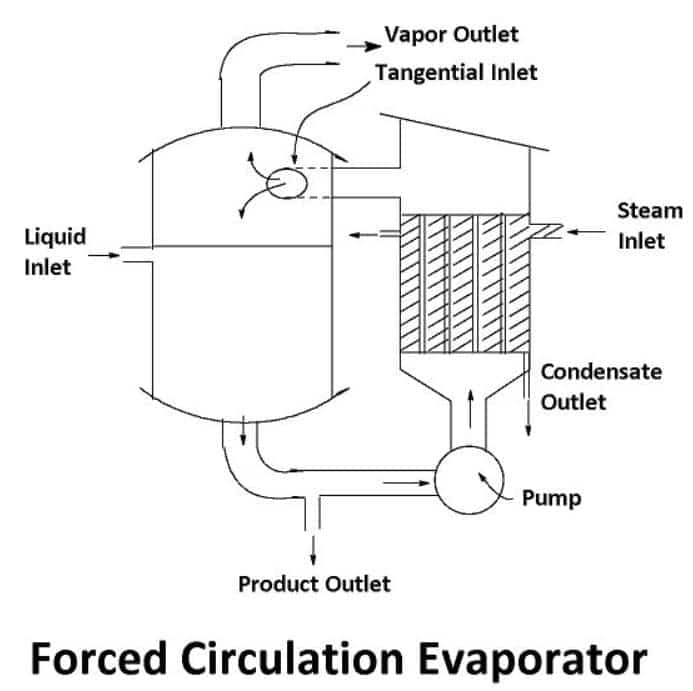
These evaporators are also known as natural circulation evaporators, and they typically operate on the principle of natural circulation as a result of the difference in density that results from heating.
Due to the use of tubes, when water begins to boil, bubbles begin to rise, which causes circulation and separates the liquid and vapor at the top of the heating tubes. The temperature difference between the solution and the steam has a direct impact on how much water evaporates.
Forced circulation evaporators are typically used in waste streams, viscous fluids, crystallizers, and various difficult process fluids. Pumps can also aid in reducing fouling, which can be caused by liquid boiling on tubes. This is because they can lessen bubble formation.
#2 Climbing and Falling Film Plate Evaporator
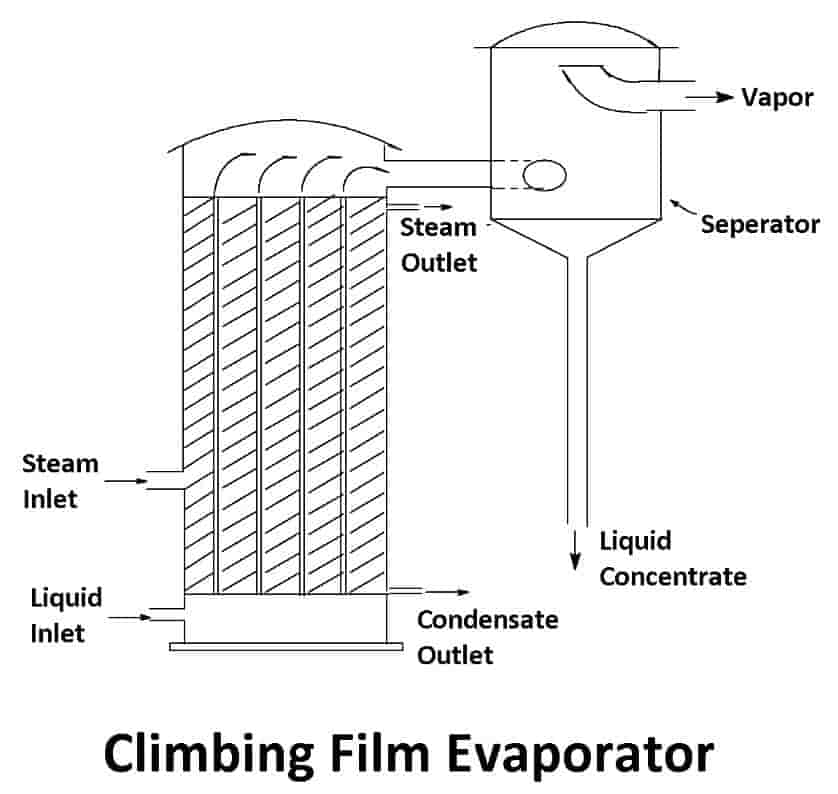
The surface area of climbing and falling-film plate evaporators is comparatively large. The frame supports the plates, which are typically corrugated. In the process of evaporation, steam travels through the channels created by the open spaces between the plates.
As the concentrated liquid rises and falls, the steam rises and falls alternately. Along with the liquid, the steam travels in a co-current, counter-current direction. In the separation stage, the concentrate and vapor are fed, which sends the vapor to a condenser.
Due to their spatial flexibility, these types of evaporators are frequently used in the fermentation and dairy industries. Its limited capacity to handle viscous or solid-containing products is a drawback of this type of evaporator. Other varieties of plate evaporators only utilize climbing film.
#3 Falling Film Evaporator
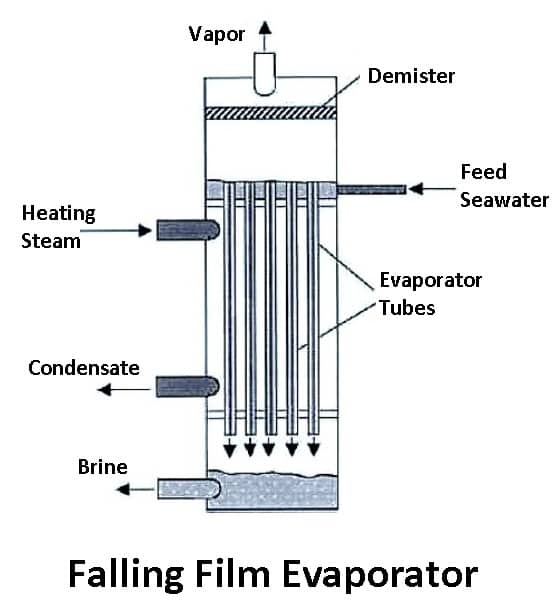
This type of evaporator is typically constructed from 4–8 m (13–26 ft) long tubes that are covered in steam jackets. When using this kind of evaporator, the solution must be distributed uniformly. As it enters and flows downward, the solution picks up speed.
The vapor is evolved against the heating medium, which also flows downward, and this is what gives the vapor its increase in velocity. These types of evaporatos are frequently used in the chemical, sugar, food, and fermentation industries because it is typically applied to highly viscous solutions.
You might like: What is a Furnace? Types of Furnaces
#4 Nucleate Boiling Evaporator
In the Nucleate Boiling Evaporator, the vapor is generated by the process of wall nucleation, which produces steam from water. The fluid is essentially boiled during this procedure.
#5 Flash Evaporator
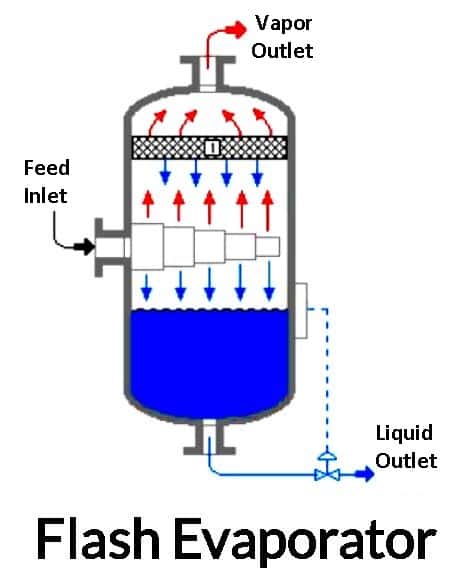
A flash evaporator is used in seawater desalination plants as a means of removing salt from seawater in order to produce distilled water. When a saturated liquid stream pressure decreases while passing through the throttle valve in this process, vapors are created.
#6 Direct Contact Evaporator
Direct contact evaporators are equipped with a hot gas injection system, which injects hot gas into a pool of liquid to be evaporated. These types of evaporators are used to evaporate corrosive and viscous liquids and are inexpensive.
You might like: Types of Forging Defects [Their Causes & Remedies]
#7 Multi-Effect Evaporator
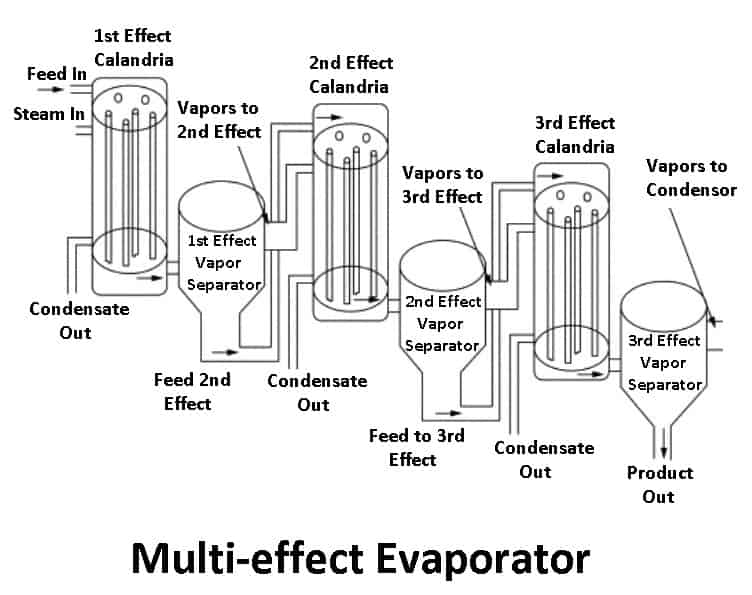
These evaporators, in contrast to single-stage evaporators, can have up to seven evaporator stages (effects). Single-effect evaporators consume a lot of energy, accounting for most of the cost of an evaporation system.
Evaporators can be constructed with less energy because they use less heat. The original evaporator can be increased by one, reducing energy usage by 50%. It drops to 33% after the addition of another effect, and so forth.
One can calculate how much they will save by increasing the number of effects using the heat-saving-percent equation. The number of effects in a multiple-effect evaporator is usually limited to seven, since after that, the equipment cost begins to approach the energy savings.
When working with multiple-effect evaporators, there are two different types of feeding that can be used:
- Forward Feeding: This happens when the product enters the system at the highest temperature through the first effect. The product is then only partially concentrated as some water is turned into vapor and carried away. It then enters the second effect, which has a slightly lower temperature. The heated vapor produced in the first stage is used as the heat source for the second effect, saving energy in the process. As a result of lower temperatures and higher viscosity, heat-sensitive products, like enzymes and proteins, are well treated. In this system, it is necessary to increase the heating surface area of the subsequent effects.
- Backward Feeding: In this process, the temperature rises as the diluted products are fed into the final effect with the lowest temperature and moved from effect to effect. The benefit of collecting the final concentrate in the hottest effect is that it makes the product extremely viscous in the last stages, which enhances heat transfer.
#8 Rising Film (Long Tube Vertical) Evaporator
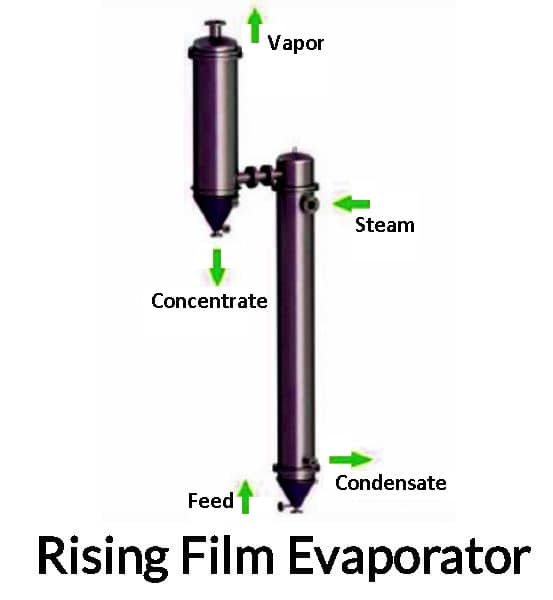
An evaporator of this type causes boiling inside the tubes when the tubes are heated (usually by steam) outside. Submergence is thus undesirable; the formation of water vapor bubbles within the tube creates an ascensional flow, which increases the heat transfer coefficient.
As a result, this kind of evaporator is quite effective; however, it has the drawback of being susceptible to rapid scaling of the internal surface of the tubes. This design is then typically applied to clear, salt-free solutions.
Typically, tubes are quite long—4 meters or more (13 feet or more). A small recycling is occasionally offered. This type of evaporator requires careful measurement of the actual level of the process liquor inside the tubes, making its sizing a challenging task. Recent applications tend to favor rising-film over falling-film patterns. Additionally, it is very helpful.
You might like: Types of Cutting Tools and Their Uses
#10 Agitated Thin Film Evaporator
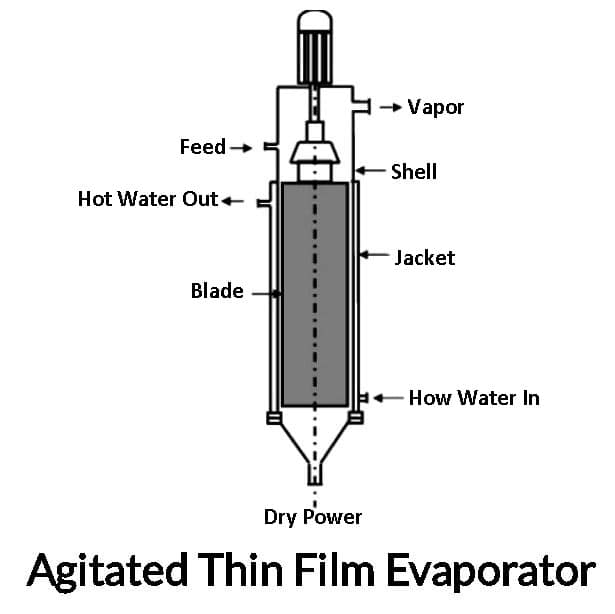
Agitated thin-film evaporation has been extremely effective for handling challenging products. The method involves indirect heat transfer and mechanical agitation of a flowing product film to quickly separate the less volatile components from the volatile ones.
The separation is typically performed under vacuum conditions to maximize ∆T and maintain the most beneficial product temperature. This ensures that the product only experiences equilibrium conditions inside the evaporator and can maximize volatile stripping and recovery.
#11 Thermal Vapor Recompression (TVR)
In its simplest form, a thermal vapor recompression (TVR) evaporator is a type of evaporator that is used as a thermal compressor in order to reduce the amount of steam required to carry out the evaporation process. A steam jet pump compresses the vapor stream to increase its temperature and pressure.
#12 Mechanical Vapor Recompression (MVR)
A mechanical vapor recompression evaporator is a device that compresses water vapor in such a way that temperature and pressure increase as a result of the compression. The temperature difference between the vapor and the fluid increases as the temperature rises.
A heat exchanger is created as a result of the additional heat transfer. The compressed vapor is recycled to produce more steam. This process is both energy-efficient and energy-recovery.
You might like: Types of Casting Defects [Their Causes & Remedies]
#13 Bare-Tube Type Evaporator
Bare tube evaporators are used in air conditioning and refrigeration. They are made up of zigzag, oval trombone-shaped hollow copper or steel tubes. In bare-tube evaporators, cooling air is passed through evaporator tubing to cool the liquid via forced convection or conduction. In big evaporators, steel tubes are typically used with ammonia as the refrigerant.
#14 Plate Type Evaporator
Plate evaporators are made up of copper or aluminum plates that are interconnected. There are several metal tubes inside these plates, through which the refrigerant that will be used in the evaporation process flows.
Plate evaporators can be used in the food industry for cooling and refrigeration because they are inexpensive. For instance, plate evaporators are used in deep freezers, cold storage, ice-cream freezers, and other commercial and residential refrigerators.
#15 Finned Evaporator
Finned evaporators are bare tube evaporators that have fins that extend from the tube’s surface into free space. They are used in air conditioning and cooling, where the cooled fluid or air passes over the evaporators.
You might like: Types of Metals: Their Properties with Examples
Applications of Evaporators
The following are the various application of evaporators:
#1 Air Conditioning and Refrigeration
While cooling the system, some air conditioners and refrigerators use compressed liquids with low boiling points that vaporize inside the unit while discharging thermal energy into the environment.
#2 Food Industry and Synthetic Chemistry
Evaporators are commonly used to purify a solution. The climbing/falling film plate evaporator is used to create condensed milk, which is one example.
The reduction (cooking) process involves removing liquids from a solution, such as wine, in order to create a “reduced” product.
The primary process in distillation is evaporation, which is used to concentrate alcohol, isolate liquid chemical products, or recover solvents in chemical reactions. Distillation is used to clean up substances in the fragrance and essential oil industries. Each application makes use of unique hardware.
#3 Chemical Engineering
Evaporation separates the desired drinking water from the undesirable solute/product, salt, in the desalination of seawater or in zero-liquid discharge plants. Evaporation is used in numerous processes in chemical engineering. The multiple-effect evaporator, for instance, is utilized in the Kraft pulping procedure, which creates wood pulp from wood.
#4 Marine
Evaporating plants are frequently carried by large ships to produce fresh water, reducing their reliance on ashore-based resources. To keep boiler water levels stable, steamships must produce high-quality distillate.
Ships powered by diesel engines frequently use waste heat as an energy source to generate fresh water. In this system, concentrated seawater is used to cool the engine cooling water as it passes through a heat exchanger. Unless the pressure in the heat exchanger vessel is lowered, it would not be possible to flash off any water vapor because the cooling water is 70–80°C (158–176°F).
Closing It Up
That’s it. Thanks for reading. I hope I have covered everything about the “types of evaporators” It would be helpful if you could let me know if there was anything I missed or if you have any doubts about anything I wrote.
Please share this article with your friends if you find it interesting.
Want free PDFs direct to your inbox? Then subscribe to our newsletter.
Download PDF file of this article:
You might like to read more in our blog:
- Drilling Machine – Parts, Types, Operations & Advantages [Ultimate Guide]
- Milling Machine – Parts, Types, Operations and Milling Cutter
- Types of Lathe Machines & Their Uses [Complete Guide]
External Links: